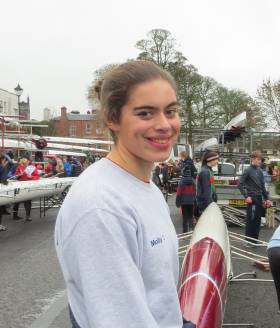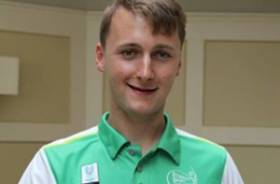Displaying items by tag: Ireland Trial
#Rowing: Gary and Paul O'Donovan, the world champions in the lightweight double, won a key race at the Ireland trials today. Fintan and Jake McCarthy were two lengths behind the O'Donovans with 400 metres to go, but tightened it to a length on the line. The trials go on, with tests of different combinations.
Conditions at the National Rowing Centre were remarkably good.
O'Driscoll and O'Donovan Trialled in a Four
#Rowing: An Ireland heavyweight four of Mark O’Donovan, Fionnan Crowley, Andy Harrington and Shane O’Driscoll got its first outing in the second session of the Ireland Trials on Saturday. Their test against Ronan Byrne and Philip Doyle – who did have a handicap of 15 seconds – ended with a victory for the double.
The pair of Monika Dukarska and Aifric Keogh got a battle from the junior double of Molly Curry and Rhiannon O’Donoghue, in a race won by lightweight single sculler Fintan McCarthy.
At the London Head of the River, provisional rankings placed Commercial’s senior eight 20th.
Doyle and Byrne Form Winning Combination at Ireland Rowing Trial
#Rowing: The double of Philip Doyle and Ronan Byrne performed brilliantly for Ireland last year, culminating with a ninth-place finish at he World Championships. They took up where they left off at the the Ireland Trial at the National Rowing Centre today. The heavyweight crew beat the lightweight double of Paul O’Donovan and Fintan McCarthy in a fine race in the first session. McCarthy and O’Donovan had never raced together before, but still finished well and were just over four seconds behind Doyle and Byrne in dead calm conditions.
Some of the contests in this first of two sessions were handicapped to produce good racing and it worked. Sanita Puspure did not win her race but had a very good time, while the pair of Aifric Keogh and Monika Dukarska won in another impressive time.
The new junior coxed four of John Kearney, Jack Dorney, James O’Donovan and Matthew Gallagher, with cox Leah O’Regan were just pipped in their race – but again excelled in terms of time for this boat.
One of the more interesting crews to be trialled was the senior four of Eimear Lambe, Aileen Crowley, Emily Hegarty and Claire Feerick. Another four was to be trialled in the second session. This opens up a possibility of a single, a pair and a four going forward on the women’s heavyweight side.
The combination of Rory O’Neill of Castleconnell and Finn O’Reilly of Skibbereen were the top men’s junior double.
O'Driscoll and O'Donovan Win at Ireland Rowing Trial
#Rowing: The top international seniors and a number of ambitious junior crews figured high in the rankings at the Ireland Trial at the National Rowing Centre today.
The battle of the men’s heavyweight pairs saw Mark O’Donovan and Shane O’Driscoll come out on top over Patrick Boomer and Fionnan Crowley. The women’s pair of Aifric Keogh and Monika Dukarska were very impressive in their win, while Paul O’Donovan – after a fine race with Ronan Byrne – won the men’s single sculls and Sanita Puspure the women’s.
Two junior crews with their eyes on the World Junior Championships excelled in their wins. The coxed four of John Kearney, Jack Dorney, James O’Donovan and Matthew Gallagher, with cox Leah O’Regan, beat an under-23 crew coxed four, while Molly Curry (Coleraine GS) and Rhiannon O’Donoghue (Killorglin) also beat the under-23 coxed four in their race.
Curry is Afloat Rower of the Month for February
#Rowing: The Afloat Rower of the Month for February is Molly Curry. In a set of weeks in which action on the water was severely limited because of windy weather, the Ireland trials at the National Rowing Centre were welcome – and of high quality. World Rowing Champions Paul O’Donovan and Sanita Puspure won in fine style, while the standard of junior rowing was notable. Curry, from Coleraine Grammar School, showed good form. She was the top woman junior in the time trial and went on to compete in the same 2,000 metre race as Puspure.
Rower of the Month awards: The judging panel is made up of Liam Gorman, rowing correspondent of The Irish Times and David O'Brien, Editor of Afloat magazine. Monthly awards for achievements during the year will appear on afloat.ie. Keep a monthly eye on progress and watch our 2019 champions list grow.
O'Donovan and O'Driscoll Win at Ireland Trial
#Rowing: Paul O’Donovan finished fifth overall in the single sculls at the Armada Cup, and Sanita Puspure third in the Gold Cup in Philadelphia, a race that was part of the Head of the Schuylkill event.
At the Ireland trial at the National Rowing Centre, Shane O’Driscoll and Mark O’Donovan won the men’s pair on Sunday, with David O’Malley and Shane Mulvaney second. O'Driscoll and O'Donovan did not compete on the Saturday.
Jack Dorney of Shandon won both the junior single sculls and the junior double, with Castleconnell’s Rory O’Neill. Molly Curry had equivalent wins: she teamed up with Lauren O’Brien – also of Castleconnell – on the Sunday.
UCD’s men’s senior eight were fastest at the Castleconnell Head of the River, and Enniskillen junior crews also shone.
Ireland Trial, National Rowing Centre (Provisional Results; winners) Saturday
Men
Pair - Senior: UCD (S Mulvaney, D O’Malley). Under-23: UCD (S O’Connell, A Goff).
Single - Senior: Shandon (A Harrington). Under-23: UCC (R Byrne)
Women
Pair: UCC, Skibbereen (A Keogh, E Hegarty). Under-23: Neptune, UCD (C Feerick, E Lambe). Jun: Cork Boat Club (C O’Sullivan, J Duggan).
Single – Sen: Killorglin (M Dukarska). Lightweight: Skibbereen (D Walsh). Under-23 Lightweight: Skibbereen (L Heaphy). Junior: Coleraine GS (M Curry).
Sunday
Men
Four – Under-23: O’Connell, Goff, Keating, Whittle. Jun 18: Gallagher, Daly, Butler, Murphy
Pair: M O’Donovan, S O’Driscoll
Double – Sen: Haugh, Crowley. Lightweight: J McCarthy, F McCarthy. Lwt U-23: Sutton, Gaffney Jun 18: Dorney, O’Neill.
Single – Sen: Byrne. U-23: Bann (Christie). Lightweight: Sutton.
Women
Four – Under-23: Hanlon, Casey, Lambe, Feerick. Jun 18: O’Sullivan, Duggan, Tyther, O’Donoghue.
Pair – Hegarty, Keogh. Jun 18: McGrath, Gannon
Double – Sen: Dukarska, Crowley. Lightweight: Walsh, Casey. Jun 18: Curry, L O’Brien.
Single – Lightweight: Legresley. U-23: Heaphy. Jun 18: Gilmore.
O'Donovans Burn Off Rivals at Ireland Rowing Trials
#Rowing: Paul O’Donovan and Gary O’Donovan produced the best performance of the first Saturday session of the Ireland trials. The lightweight double beat their Skibbereen under-23 rivals Jake and Fintan McCarthy by 8.4 seconds and a heavyweight double of Ronan Byrne (UCC) and Philip Doyle (Queen’s) by 3.9 seconds.
The heavyweight pair of Shane O’Driscoll and Mark O’Donovan also put their challengers firmly behind them. They raced at a high rate in the good conditions and beat Patrick Boomer and Andy Harrington by 6.6 seconds.
Three senior women’s crews performed well. Single sculler Sanita Puspure and the heavyweight and lightweight doubles of Monika Dukarska and Aileen Crowley and Denise Walsh and Margaret Cremen all looked on form as the selectors decide on which crews to send to the World Cup Regatta in Belgrade.
In the junior trials, Annie O’Donoghue and Ciara Moynihan of Workmen’s won a fine doubles race. Aoibhinn Keating of Skibbereen and Ciara Browne of Workmen’s were their closest rivals, but Mollie Curry of Coleraine GS and Eimear Crowley of Kenmare contended at the finish and were just 1.4 seconds off the winners.
Hot Competition at Ireland Rowing Trial
#Rowing: The standard was high at the second session of the Ireland Trial at the National Rowing Centre in Cork. Patrick Boomer and Andy Harrington again tested Shane O’Driscoll and Mark O’Donovan in the pair – this time the margin was just 1.3 seconds – and Sanita Puspure came in under seven minutes 40 seconds in another outstanding performance in the single sculls.
There was an all-Skibbereen shootout in the lightweight doubles: twins Jake and Fintan McCarthy, who are just 21, came in just 2.8 seconds behind Paul and Gary O’Donovan.
Margaret Cremen teamed up with Denise Walsh to produce a fast lightweight double, while Monika Dukarsa and Aileen Crowley formed a heavyweight double which also produced a good performance. Aifric Keogh and Emily Hegarty formed a pair which also bettered 90 per cent of projected world best time.
A second configuration of the men’s junior quad did very well, while the women’s junior double from Workmen’s again produced one of the best performances of the day.
Goff and Byrne and Pair of Hegarty and Hanlon Shine at Trial
#Rowing: Andrew Goff of UCD and Ronan Byrne of UCC impressed in the six kilometre time trial at the Ireland Assessment at the National Rowing Centre today. Goff, an under-23 lightweight, came out on top overall in the rankings when given weighting for his class, while Byrne was second, and was the best under-23 heavyweight.
The UCC under-23 women’s pair of Emily Hegarty and Tara Hanlon made their mark, while Monika Dukarska impressed in the women’s single. Sanita Puspure missed the trial through injury.
The trial was run in a strong – and rising – headwind and there is a very limited programme tomorrow, Sunday.
Ireland Trial, National Rowing Centre
(Six kilometre time trial; selected results; ranked by percentage of projected world best time)
1 A Goff (UCD; under-23 lightweight single) 24 mins 00.3 secs (83.32 per cent), 2 R Byrne (UCC; under-23 single) 23:44.1 (83.0), 3 J McCarthy (Skibbereen; u23 lwt single) 24.18.9 (82.25), 4 R Ballantine (Newcastle/Enniskillen; lwt single) 24:23.1 (82.02)
5 S Mulvaney, D O’Malley (UCD; u-23 lwt pair) 23:06.0 (81.82), 6 E Hegarty, T Hanlon (UCC; under-23 women’s pair) 25.14.5 (81.81), 7 A Crowley, A Keogh (UCC/Old Collegians; women’s pair 25:04.3 (81.17), 8 M Dukarska (Killorglin; women’s single) 26.07.4 (81.15), 9 A Harrington (Shandon/UCC; single) 23.54.6 (81.14), 10 A Casey (Skibbereen; u-23 lwt women’s single) 27:05.8 (80.45).
O'Donovans On Song at Ireland Rowing Trial
#Rowing: Paul O’Donovan and Gary O’Donovan, in a lightweight double scull, tied for the best time with a men’s heavyweight four on the second day of the Ireland trial over six kilometres today. The fastest women’s crew was the four of Tara Hanlon, Emily Hegarty, Aileen Crowley and Aifric Keogh. The double of Claire Lambe and Monika Dukarska were next fastest.
Ireland Trial, National Rowing Centre, Sunday (6 km; selected results):
Men
Four: Shandon/St Michael’s (Murphy, Prendergast, McKeon, Garvey) 21 min 22 sec
Doubles: G O’Donovan, P O’Donovan (lwt) 21:22; R Byrne, S McKeown (hwt) 21:36.
Women
Four: Old Collegians, Skibbereen, UCC (T Hanlon, E Hegarty, A Crowley, A Keogh) 22:54.
Double: M Dukarska, C Lambe (hwt) 23:12; D Walsh, A Casey (lwt) 23:35






























































